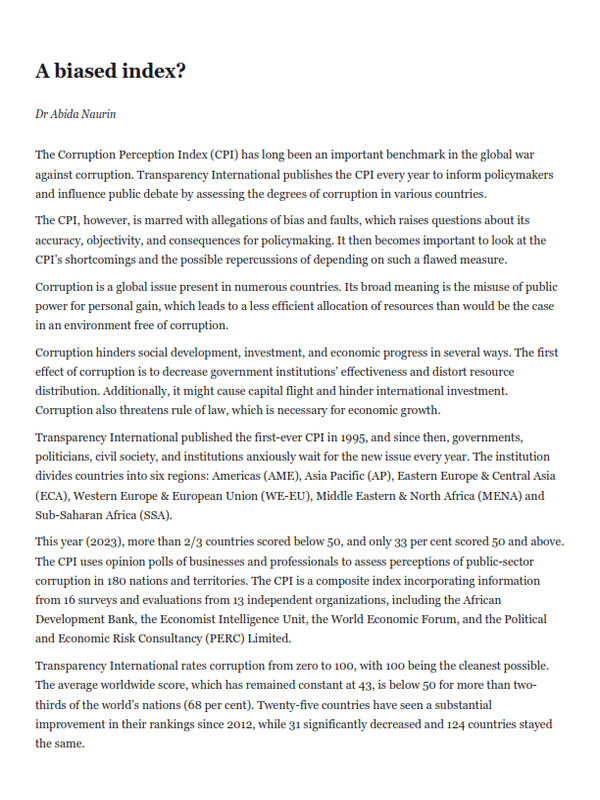A biased index?
The Corruption Perception Index (CPI) has long been an important benchmark in the global war against corruption. Transparency International publishes the CPI every year to inform policymakers and influence public debate by assessing the degrees of corruption in various countries.
The CPI, however, is marred with allegations of bias and faults, which raises questions about its accuracy, objectivity, and consequences for policymaking. It then becomes important to look at the CPI’s shortcomings and the possible repercussions of depending on such a flawed measure.
Corruption is a global issue present in numerous countries. Its broad meaning is the misuse of public power for personal gain, which leads to a less efficient allocation of resources than would be the case in an environment free of corruption.
Corruption hinders social development, investment, and economic progress in several ways. The first effect of corruption is to decrease government institutions’ effectiveness and distort resource distribution. Additionally, it might cause capital flight and hinder international investment. Corruption also threatens rule of law, which is necessary for economic growth.
Transparency International published the first-ever CPI in 1995, and since then, governments, politicians, civil society, and institutions anxiously wait for the new issue every year. The institution divides countries into six regions: Americas (AME), Asia Pacific (AP), Eastern Europe & Central Asia (ECA), Western Europe & European Union (WE-EU), Middle Eastern & North Africa (MENA) and Sub-Saharan Africa (SSA).
This year (2023), more than 2/3 countries scored below 50, and only 33 per cent scored 50 and above. The CPI uses opinion polls of businesses and professionals to assess perceptions of public-sector corruption in 180 nations and territories. The CPI is a composite index incorporating information from 16 surveys and evaluations from 13 independent organizations, including the African Development Bank, the Economist Intelligence Unit, the World Economic Forum, and the Political and Economic Risk Consultancy (PERC) Limited.
Transparency International rates corruption from zero to 100, with 100 being the cleanest possible. The average worldwide score, which has remained constant at 43, is below 50 for more than two-thirds of the world’s nations (68 per cent). Twenty-five countries have seen a substantial improvement in their rankings since 2012, while 31 significantly decreased and 124 countries stayed the same.
An important research report ‘Is Corruption Perception Index (CPI) Biased? An Ethnicity-based Analysis’ by the Pakistan Institute of Development Economics (PIDE) aims to investigate the relationship among economic growth, ethnicity, and panel-country corruption levels. Specifically, it seeks to answer the question: do economic growth and ethnicity explain the differences in panel-country corruption levels?
Ethnicity and economic growth are two important factors influencing corruption levels in a country. Therefore, understanding the factors contributing to corruption is essential for policymakers to develop effective measures to combat it.
The main findings of this research report indicates that countries with a large white population (West Europe/EU) have scored higher (above median) in the index than other regions. Surprisingly, better CPI scores and good per-capita income have a strong positive relationship with such countries in empirical analysis. These results suggest that economic growth can effectively reduce corruption in countries with diverse ethnic populations. We call a country ‘best performer’ if it has a good score in the CPI and higher per-capita income.
Most European countries (white race) fall in the ‘best performing group’. It is also observed that Canada and the US (from the region Americas) and Australia and New Zealand (from Asia and the Pacific) also fall in the best-performing group.
The CPI mainly relies on perceptions, collecting information through surveys and professional judgements. While it is true that understanding corruption depends on people’s observations and views, but such opinions are fundamentally flawed and sensitive to other influences. Individual opinions on corruption can be influenced by things like cultural differences, media depictions, and personal experiences, which could result in bias in the data gathered.
On this basis, it is safe to assume that the CPI only provides a limited view based on personal perceptions, which may not always accurately reflect the real level of corruption in a country.
Transparency International should regularly examine and improve the CPI methodology to address its bias and constraints. Achieving higher reliability and accuracy can entail adding objective indicators, considering alternate data sources, and doing meticulous statistical analysis.
To get a fairer and complete view of corruption, policymakers must consider using various corruption indices and data sources. It may be challenging to develop effective policy by relying simply on the CPI, resulting in a biased view of corruption dynamics.
Policymakers may take a more nuanced and evidence-based approach to fighting corruption by admitting the bias involved in the index, ultimately formulating, and applying more effective policies.
The writer is a research fellow at the Pakistan Institute of Development
Economics (PIDE), and tweets/posts @abida_15




